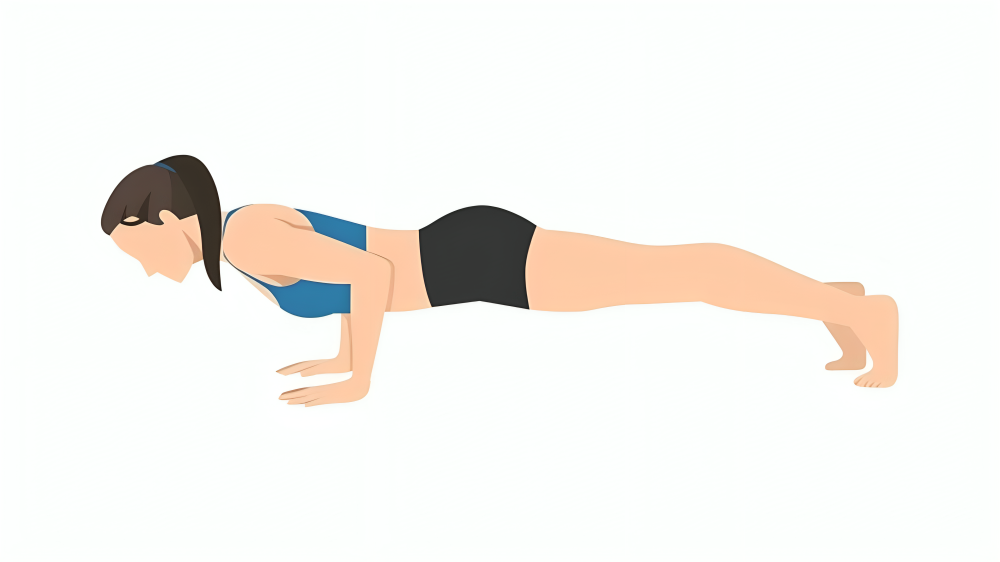
what is Chaturanga Asana
The yoga posture involves carrying one’s body in a low plank position, which is commonly used as an intermediary pose in many yoga flows, especially in Sun Salutations. Deriving from the Sanskrit, “chaturanga” literally translates to four limbs, which refers to hands and feet when they are utilized in support for the body, while “Dandasana” or “staff pose” refers to the straight alignment of the body like a staff or rod.
How to Do Chaturanga Asana
Align yourself properly before you get on with it because poor alignment is a certain surefire means of hurting yourself. Here’s how you can do Chaturanga Asana:
Start in a High Plank
Start your exercise in a plank pose, hands right under the shoulders, fingers spread apart.
Engage your core so that your body aligns straightly from head to heels.
Press into the toes while keeping legs active.
Engage Your Core and Lower Down
Push yourself out on an exhalation and bend elbows directly back- don’t swing out to the sides.
Lower your torso straight down from shoulders to elbows, hovering about two or three inches above the mat.
Keep your elbows close to your ribs. Avoid letting your shoulders drop below the level of your elbows, a common mistake.
Hold the Pose
Control the hold on the low plank position with the body alignment. Chest, hips, and thighs should hover about the same distance above the mat.
Maintain the engagement in your core, glutes, and thighs. Your lower back should not sag.
Transition or Return to Plank
From Chaturanga, you can either flow into Upward Facing Dog or push back into a Downward Dog.
Drop to your knees and to the mat. It reduces the load on your arms and allows you to focus on proper form.
Benefits of Chaturanga Asana
Builds Upper Body Strength
Chaturanga strengthens the arms, shoulders, chest, and wrists. It’s sort of like doing a yoga push-up, and when done right, can really tone your muscles but also improve your endurance.
Tones the Core
This asana is a great core exercise. Since you need to engage your abdominal muscles to maintain form, Chaturanga can improve a strong and stable core, which is essential for most yoga poses and movement in daily life.
Strengthens the Posture
Chaturanga will really train your posture. The more powerful the muscles around your shoulders and spine are, the less likely you are to slouch over in class.
Boosts Balance and Stability
Your body is supported a few inches above the ground on four contact points. You’ll need balance and focus to hold that position.
It’s Here Balasana (Child’s Pose) how to do it and what are the Benefits
FAQs
1. What is Chaturanga Asana?
Chaturanga Asana, also known as Chaturanga Dandasana or Four-Limbed Staff Pose, is a foundational yoga posture that engages the entire body. It is commonly part of the Sun Salutation sequence and serves as a preparatory pose for more advanced arm balances.
2. Is Chaturanga the same as a push-up?
While Chaturanga looks similar to a push-up, it’s different in terms of alignment. In Chaturanga, your elbows stay tucked close to your ribs, and the pose requires more core engagement to maintain proper alignment. A standard push-up allows more freedom in elbow positioning.
3. How long should I hold Chaturanga Asana?
There’s no fixed time for holding Chaturanga, but you can start with 5 to 10 seconds, gradually increasing as you build strength. Ideally, you should hold it long enough to maintain proper form without straining.
4. What muscles does Chaturanga Asana work?
Chaturanga targets several key muscles:
Core muscles (abs and obliques)
Upper body (shoulders, chest, and triceps)
Back muscles
Glutes and legs also engage to stabilize the pose.
5. Why is Chaturanga so difficult?
Chaturanga is challenging because it demands both strength and control. It requires you to hold your body in a plank position while lowering with precision. Weakness in the core, shoulders, or arms can make this pose particularly tough.

